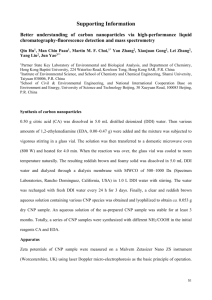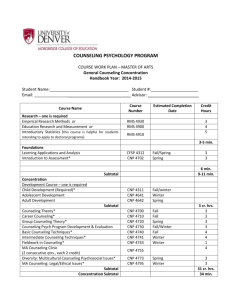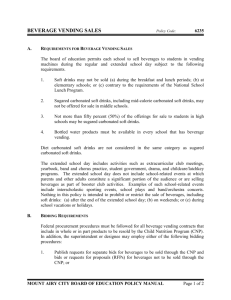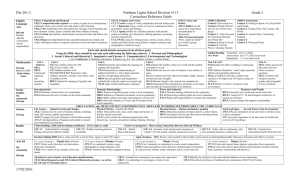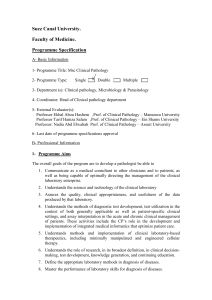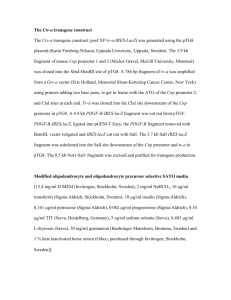advertisement
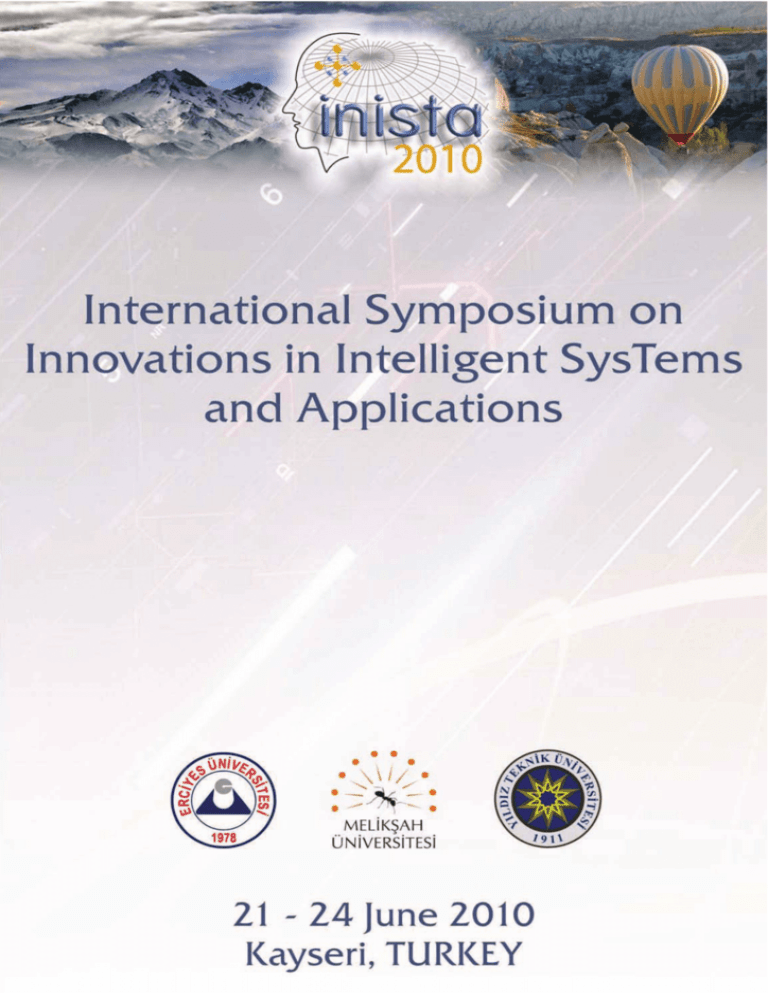
INISTA 2010
International Symposium on INnovations in Intelligent SysTems
and Applications
Organized by
in cooperation with
Technical Co-Sponsors
Sponsors
21-24 June 2010, Kayseri & Cappadocia, TURKEY
INISTA 2010
International Symposium on INnovations in Intelligent SysTems
and Applications
ISBN 978-975-6478-58-5
Proceeding Book Name
International Symposium on INnovations in Intelligent SysTems and Applications
INISTA 2010
Editors
Tülay YILDIRIM
Mehmet Emin YÜKSEL
Alper BATÜRK
Enis GÜNAY
Cover Design
Nurettin ÜSTKOYUNCU
Rifat KURBAN
Fehim KÖYLÜ
Mehmet YILDIRIM
21-24 June 2010, Kayseri & Cappadocia, TURKEY
INISTA 2010
International Symposium on INnovations in Intelligent SysTems and Applications, 21-24 June 2010, Kayseri & Cappadocia, TURKEY
Procedural and Non-Procedural Implementation of Search Strategies in
Control Network Programming
Kostadin Kratchanov1, Emilia Golemanova2, Tzanko Golemanov2,
Tuncay Ercan1 and Burak Ekici1
1
Department of Computer Engineering, Yasar University, Universite Cad. Yagacli Yol
No.35-37, Bornova/Izmir, 35100 Turkey
{kostadin.kratchanov, tuncay.ercan}@yasar.edu.tr
2
Department of Computing, Rousse University, 8 Studentska Street, Rousse, Bulgaria
{EGolemanova, TGolemanov}@ecs.ru.acad.bg
successfully finish when the interpreter arrives at a
system node FINISH. The computation/search
strategy is an extended version of backtracking;
one of the major enhancements is the possibility to
backtrack through a subnet.
CNP allows a convenient combination of
procedural and non-procedural features – while
the structure of the CN is generally nonprocedural
(i.e., can be a simple representation of the problem
without specifying any algorithm for solving this
problem) and nondeterministic, the primitives
used in it are procedural. However, procedural
solutions can also be easily programmed.
The syntax and semantics of CNP, and most
specifically of the CNP programming language
Spider, have been described in [1-3].
Representative examples of using CNP for solving
various types of problems have been considered in
[4]. Programming environments for developing
and running CNP applications are available for
free download at [5]; the code of all examples
from the mentioned publications has also been
posted there.
CNP supports powerful means (system options
and control states) that give the programmer
extensive control over the computation
(inference). Using these means the programmer
can improve the efficiency of the computation and
easily implement various types of heuristic
algorithms. These control features are their usage
are studied in [6-8].
Abstract
This report presents the general picture of how
Control Network Programming can be effectively
used for implementing various search strategies,
both blind and informed. An interesting possibility
is non-procedural solutions that can be developed
for most local search algorithms. A generic
solution
is
described
for
procedural
implementations.
1. Introduction
Control Network Programming (CNP)
evolved as a programming paradigm by
combining features from imperative programming,
declarative programming, and problem solving
with rule-based systems, at the same time
substantially extending their potential [1].
1.1. Control Network Programming
Ɍhe program in CNP can be visualized as a
finite set of graphs referred to as a control
network (CN). The graphs comprising the CN are
called subnets; one of them is identified as the
main subnet. Each subnet consists of nodes
(states) and arrows. A chain of “primitives” is
assigned to each arrow. The primitives may be
thought of as elementary actions and are
technically user-defined procedures. A subnet may
call other subnets or itself. Both subnets and
primitives can have parameters and variables. The
complete program consists of two main
components - the CN and the definitions of the
primitives.
The program is a possibly nondeterministic
description of a problem. “Executing” the CN
means traversing the CN starting from the unique
initial node of the main subnet and executing the
primitives along the way. This process will
1.2 Purpose of this report
Search algorithms play a fundamental role in
Artificial Intelligence. They also attract
considerable interest in Algorithm Design,
Computability Theory, Operations Research, some
areas of Mathematics and Engineering, Robotics,
Bioinformatics, and other fields.
386
INISTA 2010
International Symposium on INnovations in Intelligent SysTems and Applications, 21-24 June 2010, Kayseri & Cappadocia, TURKEY
algorithm that generalizes all mentioned strategies.
Then we create the corresponding UML activity
diagram and (in an almost trivial manner) convert
this diagram into a CN. A similar conversion was
used in [4] for solving the Selection Sort example.
The generic search algorithm is unique and
works for all strategies; the strategy is being
chosen through a dialogue with the user. The
generic algorithm is based on the observation that
all other search strategies under consideration are
actually special cases of the A* algorithm. A
similar but narrower universality observation can
be found in [10,11].
Numerous examples of using CNP for
implementing search strategies are discussed in
[8]. The focus is on employing the built-in tools
for dynamic control of the computation process
for automatic, non-procedural modeling of certain
search strategies.
This report studies the possibilities for
programming search algorithms in CNP in a more
general framework. Two major implementation
techniques are outlined. In the first approach, the
classical search algorithms are essentially
simulated in CNP – we refer to such
implementations as procedural implementations.
We describe a generic search CNP solution which
can be used for modeling many fundamental
strategies for uninformed or for heuristic search.
Then, for a group of search strategies that we call
local search strategies, we show a very different
approach where the CN simply describes the
problem but includes no explicit procedure for
implementing the search process at all; instead,
dynamic control system options and control states
are used in order to enforce the interpreter to
“automatically” perform the desired search
strategy. We refer to this type of implementations
as non-procedural implementations. Finally,
certain search strategies require an approach that
combines features of both procedural and nonprocedural implementations.
The Spider code of all examples described here
is available at [5]. Typically, each strategy is
applied for two particular problems – the road map
problem [3,7-10] and the 8-puzzle problem (e.g.,
[9-11]). The specific map used in the examples is
the one shown in Fig.7 of [3] and Fig.3 of [7].
2. Procedural Implementation
Search Strategies
Figure 1. The generic search algorithm
of
This approach can be used for implementing
many of the fundamental search strategies, both
blind and informed; the strategies we cover are
breadth-first, depth-first (leap frogging), uniformcost, best-first, A*. The strategies use data
structures usually called CLOSED and OPEN
containing, respectively, the nodes already
explored and the nodes at the fringe of the search.
Each node may be accompanied by some
additional information such as the cost from the
initial node to this node, a heuristic evaluation of
the cost from this node to a final node, a parent of
the node. While CLOSED is theoretically a set,
container OPEN is ordered (the order depending
on the strategy being implemented).
Figure 2. Procedure pushOpen
The pseudo-code of the generic algorithm is
shown in Fig. 1. It uses function pushOpen
specified in Fig. 2.
We distinguish between a state and a complete
state. The latter is an ordered quadruple
<state,g,h,parent> where g and h are values called
cost and heuristic evaluation, respectively. The
last component, parent is used for restoring the
solution path after finding a solution. OPEN is a
set of complete states. At each step of the
algorithm it is re-ordered with respect to a
2.1 The generic search algorithm
In order to come up with a CNP solution, we
develop first the pseudo-code of a generic search
387
INISTA 2010
International Symposium on INnovations in Intelligent SysTems and Applications, 21-24 June 2010, Kayseri & Cappadocia, TURKEY
search. We assume here that optimal for both costs
and heuristic evaluations means the smallest.
The activity diagram of the generic search
algorithm is shown in Fig. 3. The CN of the CNP
implementation is illustrated in Fig. 4.
Figure 3 The generic search algorithm activity diagram
strategy-dependent function, f referred to as the
total function.
Function makeInitEntry(state) converts state
into a corresponding complete state <state,0,?,
nil>. CLOSED is a set of complete states.
Procedure popOpen(S) assigns its output
parameter S of type complete state the value of the
first element of OPEN, and removes this element
from OPEN. The solution is typically a path of
states. It can be restored from the final state using
the parent components in CLOSED. It might also
contain additional information
such as the cost of the
solution.
Procedure
findChildren(S) generates the
set of all successors of the
complete state S – the current
state. This procedure is
problem-dependent.
If
S=<state,g,h,parent> then, for
each successor, newState of
state, the cost of newState will
be calculated as follows: for
Ⱥ* and unified-cost search
newState.g:=state.g+ arc_cost
(state,newState)
where
arc_cost(state,newState) is the
cost of the arrow between the
two states; for best-first,
breadth-first and depth-first
search strategies newState.g:=
state.g+1 (i.e., depth). The
heuristic evaluation of the
child is calculated by a problem-dependent
function, h. The value newState.parent is set to
state.
Procedure
pushOpen
is
strategyindependent. Some of the children of S are killed;
the surviving children are pushed into OPEN. The
algorithm of this procedure becomes clear from
Fig. 2. Set OPEN is sorted in ascending order
according to the values of the following
algorithm-dependent total function: for a given
complete state T=<state,g,h,parent> the value
f(T) is equal to g+h if the strategy is A*, equal to h
for best-first search, to g for the uniform-cost and
breadth-first strategies, and to –g for depth-first
Figure 4. CN for the generic search algorithm
Note that the CNP implementation of the
generic search algorithm discussed above is
universal and covers all the search strategies under
consideration. The actual strategy is chosen by the
user during an initial dialogue (in which the initial
and the final states are also specified). In our
implementation, the code of all primitives is
generic and does not depend on the strategy. The
Figure 5. Non-recursive hill-climbing
choice of the strategy made by the user is used in
two simple supporting functions – one employed
in primitive findChildren to calculate g, and one in
primitive sortOpen for calculating f (see the
explanations above).
In addition to being strategy-independent, the
CN is also problem-independent - the same for
different problems for which a given search
strategy is applied (e.g., for the road map and 8puzzle problems). As far as not only the CN but
the complete CNP code is concerned, certain
components must necessarily be problemdependent. In our particular implementation
(available at [5]), problem-dependent are a few
388
INISTA 2010
International Symposium on INnovations in Intelligent SysTems and Applications, 21-24 June 2010, Kayseri & Cappadocia, TURKEY
we simply declaratively describe the problem and
leave the inference to the interpreter. Eventually,
the CNP programmer might want to use some of
the
static
search control tools [3] for a better efficiency, to
solve some problems related to non-termination,
to
specify other requirements such as the maximum
number of the solutions required or the maximal
length of the solution paths.
There are numerous other search strategies –
both heuristic or improved uninformed ones - that
have evolved from backtracking. Non-procedural
implementations of some of them were described
in [8] with complete codes shown at [5]: optimal
search with cutting off insipid paths (branch-andbound), hill climbing, irrevocable hill climbing,
nearest neighbor search, version of beam search,
stochastic hill climbing, first-choice hill climbing.
In all these implementations we have made use of
the so called tools for dynamic control of the
computation – dynamic control system options
and control states [7,8]. Applying such tools the
CN programmer can easily model different modes
of choice of which arrow emanating from the
current node to attempt first (such as the
seemingly best first, or randomly, or within a
range of evaluations, or a restricted number of
arrows, etc.). The programmer can also modify
other parameters of the backtracking (e.g., forbid
backtracking). Such modifications can be even
performed dynamically (using variables whose
values can be change during computation).
help functions such as arc_cost and h. Of course, a
few problem-dependent data structures will also
be needed such as, for example, the representation
of the map in the road map problem.
2.2 Using strategy-dependent solutions
One could also write separate (and probably
more efficient) CNP implementations for a
specific strategy. Even for such an algorithm the
CN will remain unchanged. Simply, some of the
primitives used must be adjusted to the particular
strategy. Mainly, this will affect primitives
pushOpen and sortOpen.
2.3 Abstraction and expressiveness of CNP
procedural implementation
The CNP simulations of the search strategies
discussed in Section 2 are simple to apprehend,
design and implement but at the same time are
rather general and abstract. (Well, one should
expect similar characteristics from a CNP
solution.)
It is worth mentioning that ideas similarly
related to abstraction and generality can be found
in well-designed object-oriented implementations
of the search algorithms (e.g., [12]). These
implementations use advanced object-oriented
programming concepts such as abstract classes
and interfaces. We would like to note that a CNP
solution in a CNP environment with an objectoriented underlying language (environments such
as WinSpider or Spider# - the latter being
currently developed) could combine such typical
advanced OOP possibilities with the possibilities
offered by CNP itself.
The CNP solutions in Section 2, however, do
not show the really great potential of CNP. The
reason is the fact that the above implementations
actually emulate procedural algorithms and,
consequently, do not involve any nondeterminism.
3. Non-Procedural Implementation of
Local Search Strategies
In order to be able to create non-procedural
search implementations we must make use of the
built-in in CNP search mechanism which is an
extended version of backtracking [1-3,6,7]. Then
we will be able to use a descriptive-type CN, and
it is the built-in interpreter’s responsibility to
“compute” the CN by finding a successful path
from the initial to a final node.
Trivially, if the search strategy we want to
model is backtracking (or we don’t care what
search strategy will be used) then there is no need
to write a corresponding search procedure at all –
Figure 6. Recursive hill-climbing
Basically, a programmer can do anything they
want with the arrows of the current state. The
control may backtrack to a neighboring state
which then becomes current. Therefore, we refer
to this group of search strategies as “local search
strategies”. This phrase is related to but is not
identical with the phrase “local search” as usually
understood in the literature [10,13,14] where the
389
INISTA 2010
International Symposium on INnovations in Intelligent SysTems and Applications, 21-24 June 2010, Kayseri & Cappadocia, TURKEY
Non-local algorithms can be modeled using
directly the presented generic procedural CNP
solution or at least using the underlying pattern.
Finally, more complex algorithms may require a
mixed approach comprising elements of both
types – procedural and non-procedural – at
different levels.
6. References
[1] K.Kratchanov, T.Golemanov and E.Golemanova,
“Control Network Programming”, In: 6th IEEE/ACIS
Conf. on Computer and Information Science (ICIS
2007), Melbourne, Australia, 2007, pp. 1012-1018.
[2] K.Kratchanov, E.Golemanova and T.Golemanov,
“Control Network Programs and Their Execution”, In:
8th WSEAS Int. Conf. on Artificial Intelligence,
Knowledge Engineering and Data Bases (AIKED 2009),
Cambridge, UK, 2009, pp. 417-422.
[3] K.Kratchanov, T.Golemanov and E.Golemanova,
“Control Network Programs: Static Search Control with
System Options”, In: 8th WSEAS Int. Conf. on Artificial
Intelligence, Knowledge Engineering and Data Bases
(AIKED 2009), Cambridge, UK, 2009, pp. 423-428.
[4] K.Kratchanov, E.Golemanova and T.Golemanov,
“Control Network Programming Illustrated: Solving
Problems With Inherent Graph-Like Structure”, In: 7th
IEEE/ACIS Conf. on Computer and Information Science
(ICIS 2008), Portland, OR, USA, 2008, pp. 453-459.
[5] www.controlnetworkprogramming.com
[6] E.Golemanova, K.Kratchanov and T.Golemanov,
“Spider vs. Prolog: Computation Control”, In: 10th Int.
Conf. on Computer Systems and Technologies
(CompSysTech 2009), Rousse, Bulgaria, 2009, pp. II.101-II.10-6, Also: ACM International Conference
Proceeding Series, Vol. 433.
[7] K.Kratchanov, T.Golemanov, E.Golemanova and
T.Ercan, “Control Network Programming with
SPIDER: Dynamic Search Control”, to be presented to:
14th Int. Conf. on Knowledge-Based and Intelligent
Information & Engineering Systems (KES 2010),
Cardiff, UK, 2010
[8] K.Kratchanov, E.Golemanova, T.Golemanov and
T.Ercan, “Nonprocedural Implementation of Local
Heuristic Search in Control Network Programming”, to
be presented to: 14th Int. Conf. on Knowledge-Based
and Intelligent Information & Engineering Systems
(KES 2010), Cardiff, UK, 2010.
[9] J.Pearl, Heuristics. Intelligent Search Strategies for
Computer Problem Solving, Addison-Wesley, Reading,
MA, 1984.
[10] S.Russell and P.Norvig, Artificial Intelligence: A
Modern Approach, 3rd ed. Prentice Hall, Upper Saddle
River, NJ, 2010.
[11] C.Thornton and B.du Boulay, Artificial
Intelligence. Strategies, Applications, and Models
Through Search, 2nd ed. Amacom, New York, 1998.
[12] G.F.Luger and W.A.Stubblefield, AI Algorithms,
Data Structures, and Idioms in Prolog, Lisp, and Java,
Addison-Wesley, Boston, 2008.
[13] A.Levitin, Introduction to the Design and Analysis
of Algorithms, 2nd ed., Addison-Wesley, Boston, 2007.
[14] G.F.Luger, Artificial Intelligence: Structures and
Strategies for Complex Problem Solving, 6th ed.
Addison-Wesley, Boston, 2009.
Figure 7. Simulated annealing
emphasis is different. Note also, that our local
search is usually revocable.
For more information on implementations of
local search strategies the reader is referred to
[7,8]. Only one example is shown here in Fig. 5 –
one of the three discussed implementations of the
hill climbing algorithm for a given road map that
includes cities A through H.
When the state space is large, it is preferable to
apply recursive CNP solutions. A recursive
equivalent of the hill-climbing strategy for the
road map problem is shown in Fig. 6. More details
can be found in [8]. Note that the recursive
solution remains non-procedural – hidden for the
programmer backtracking is possible back through
subnet calls.
4. Mixed Implementations
Not all local search algorithms, however, are
suited
for
fully
non-procedural
CNP
implementation. Some more complex strategies
include
elements
that
need
procedural
implementation. The resulting CN solution should
be called a mixed implementation.
An example (from [8]) is shown in Fig. 7. It
represents a solution to the Traveling Salesperson
Problem (for cities A, B, C and D) using the
Simulated
annealing
heuristic
strategy.
MonteCarloStep subnet defines declaratively a
‘chunk’ of the state space. The outer loop typical
for the simulated annealing strategy, is modeled
by the main subnet.
5. Conclusion
The report identifies, classifies and illustrates the
ways in which search problems may be
approached by a CNP programmer. Many local
search strategies based on or derived from
backtracking
and
hill-climbing
can
be
non-procedurally
implemented
using
the
supported in CNP tools for computation control.
390
